Be Going To & Present Continuous ESL Activities, Games & Worksheets
Find Someone Who...
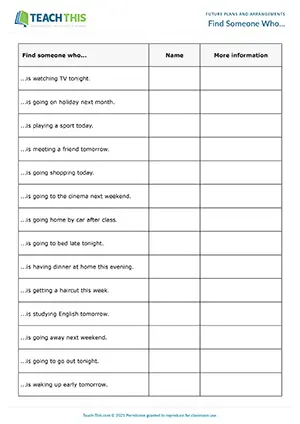
ESL Be Going To and Present Continuous Activity - Grammar and Speaking: Forming, Asking and Answering Questions, Communicative Practice
This 'be going to' and present continuous speaking activity helps students practice forming, asking, and answering yes/no questions about future...
Summer School Fair
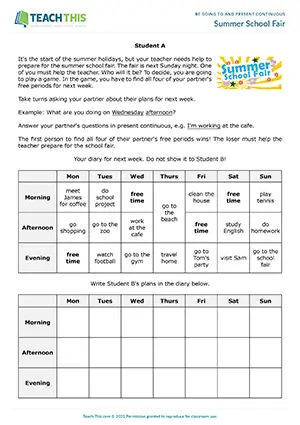
ESL Be Going To and Present Continuous Activity - Grammar and Speaking: Information Gap, Asking and Answering Questions - Pair Work
In this free 'be going to' and present continuous activity, students practice asking and answering questions about future plans and intentions. Tell the...
Fixed and Intended Future Plans

ESL Be Going To and Present Continuous Worksheet - Grammar Exercises: Gap-fill, Categorizing, Matching, Writing Sentences
In this comprehensive 'be going to' and present continuous worksheet, students practice using the present continuous for fixed future plans and 'be going to' for intended future plans...
Next Week

ESL Be Going To and Present Continuous Activity - Speaking: Asking and Answering Questions, Table Completion, Freer Practice
In this useful ‘be going to’ and present continuous activity, students plan a schedule for next week with leisure activities and then make and confirm arrangements with classmates using...
Who wrote this sentence?

ESL Be Going To and Present Continuous Game - Grammar and Speaking: Writing Sentences, Asking and Answering Questions, Freer Practice
In this entertaining 'be going to' and present continuous game has students write true sentences about their future plans and definite arrangements, then...
Future Forms Face-Off
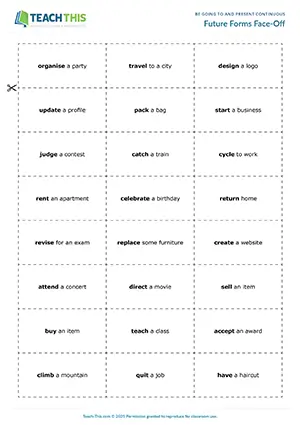
ESL Be Going To and Present Continuous Game - Grammar and Speaking: Forming Sentences, Impromptu Speech, Communicative Practice - Group Work
In this inventive 'be going to' and present continuous game, students practice talking about intentions, plans, and fixed future arrangements for different...
That Sounds Like a Plan
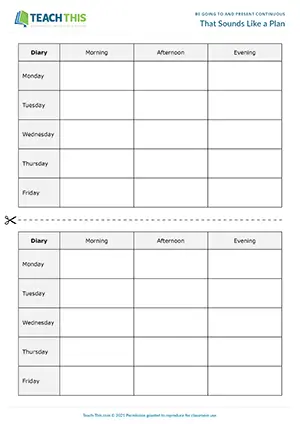
ESL Be Going To and Present Continuous Activity - Grammar and Speaking: Asking and Answering Questions, Giving Reasons, Communicative Practice - Group Work
This productive 'be going to' and present continuous activity helps students practice the difference between 'be going to' for future plans or intentions and...
The Explanation Game

ESL Be Going To and Present Continuous Board Game - Grammar: Forming Sentences - Group Work
In this free 'be going to' and present continuous board game, students talk about future plans and definite arrangements, explaining reasons with 'because' and results with 'so'. In groups, students...
The Long Weekend
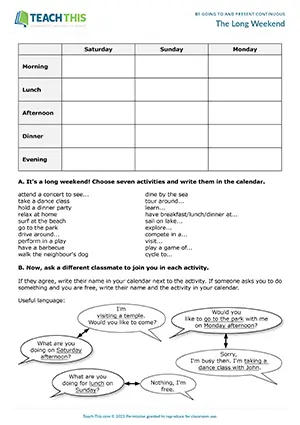
ESL Be Going To and Present Continuous Activity - Grammar and Speaking: Asking and Answering Questions, Writing Sentences, Communicative Practice
In this communicative 'be going to' and present continuous activity, students plan a long weekend by stating intentions and turning them into...
Your Future in 30 Seconds
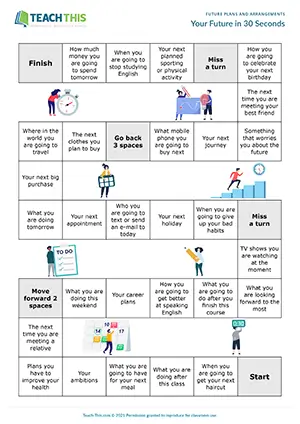
ESL Be Going To and Present Continuous Board Game - Grammar and Speaking: Impromptu Speech, Communicative Practice - Group Work
In this fun 'be going to' and present continuous board game, students talk about different future plans or arrangements for 30 seconds. Players take turns...

